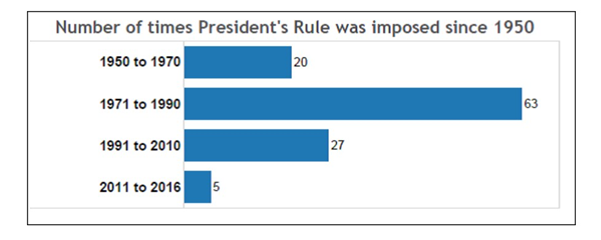Answer:
APPROACH AND STRUCTURE
THE INTRODUCTION: Write that the Indian polity differs from the classical federations in that it also has unitary features like emergency provisions under Part XVIII.
THE BODY
-
- Then write basics of Art 356
- Then write about the evolutionary aspects of the imposition of Art 356 in brief.
- Write about the legal and political factors leading to reduction of use of Art 356
THE CONCLUSION: Today the motto of the central government is cooperative federalism. In this background, the number of Article 356 usage has drastically come down, although there are issues in centre-state relations like governors’ office, misuse of investigation agencies, etc.
THE INTRODUCTION:
The Indian polity differs from the classical federations in that it also have unitary features like emergency provisions under Part XVIII.
THE BODY:
Due to the peculiar circumstances under which the country got independence, emergency provisions have been incorporated into the Constitution. There are three types of emergency: National, State emergency ( Presidential Rule) and Financial emergency. Art 356 of the Constitution deals with President’s rule in the state. It gives the President the authority to take over any or all executive powers of a State. The President can take such action based on the State Governor’s report that informs him that the State is not functioning according to the Constitution. He can also impose Art 356 without such a report of the governor.
Article 355 imposes a duty on the Centre to ensure that the government of every state is carried on in accordance with the provisions of the Constitution. It is this duty in the performance of which the Centre takes over the government of a state under Article 356 in case of failure of constitutional machinery in state. When there is a breakdown of the constitutional machinery in the state, the Union takes over the function of the state, and the federation more or less becomes unitary vis a vis that state.
Although meant to be an exceptional measure, it has been used extensively pre 1990s for political and personal reasons. According to a RTI response from the Ministry of Home Affairs (MHA), President’s rule was imposed 115 times till 2016. The imposition of President’s rule in states has varied across various decades. It was used 20 times between 1950 and 1970. Between 1971 and 1990, it was used 63 times, an average of 3 times a year. In fact, it was used 49 times between 1970 and 1980, highlighting the polarized political atmosphere during those times. Article 356 was used as a political tool during those times.

But the indiscriminate use of article 356 has come down following the legal and politcval changes since mid 1990s. Between 1991 and 2010, it was used 27 times. Only in 1991 and 1992, it was used 9 times. Between 2011 and 2016, it has been used 5 times, including 3 times after the BJP came to power in 2014.
LEGAL FACTORS:
-
- The indiscriminate use of Article 356 came down significantly following the Supreme Court’s landmark judgment in the S R Bommai case in 1994.
- The SC has laid down the grounds for imposition and non-imposition of Art 356 and also brought the imposition under the purview of Judicial Review. The judgement also affirmed that the majority of the government needs to be ascertained on the floor of the house.
- In Rameshwar Prasad 2006, the SC said that Art 356 is an emergency power and should not be used arbitrarily. The SC after that also in other cases like in Arunachal Pradesh, Maharashtra and the HC of UK etc have further used judicial review to prevent misuse of Art 356.
- The Anti Defection law was strengthened since 91st CAA which provided more stability to the governments.
Political Factors:
-
- Coalition governments at the union level since the 1990s have enabled regional parties to have a greater degree of participation in decision-making at the union For instance, till 2014, the coalition governments governed at the central level.
- The party systems have become more democratized, and a large number of regional parties have emerged, which have diluted the hold of one party over the levers of power.
- Political decentralization through the 73rd and 74th CAA has generated local leadership and awareness among people, and hence, the political development of people prevented misuse of political power.
- Civil society has emerged as an important actor in governance, and they has mobilized the people promoted political education, and worked to bring more transparency and accountability to the political system.
- Federalism has been increasingly asserted by the regional parties in the light of SC holding it as a basic feature and the emergence of strong CMs , awaked public opinion, media scrutiny etc have further strengthened checks against the misuse of Art 356.
- The governments at the Union decided to focus on governance and development for winning votes and elections rather than through Art 356 dislodging govts and then forming alternative govt.
THE CONCLUSION:
Thus, since 1990s the number of imposition of article 356 have come down due to the intervention of the judiciary, legal changes and also through the changes in political dynamics at the Central and the state level. Today the motto of the central government is cooperative federalism, and it has taken number of initiatives for strengthening the states and the centre works on the philosophy of strong States make strong nation. It also set up the NITI Aayog as the instrument of cooperative federalism. In this background, the number of Article 356 usage has drastically come down, although there are issues in centre-state relations like governors’ office, misuse of investigation agencies, etc.
Spread the Word
